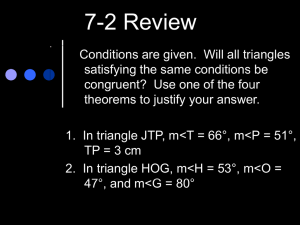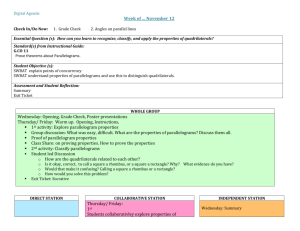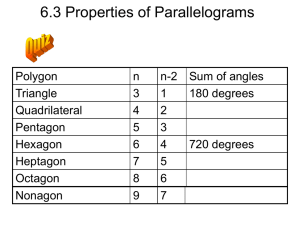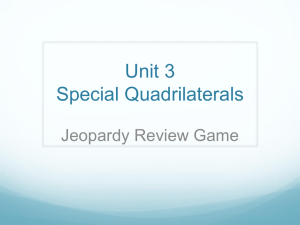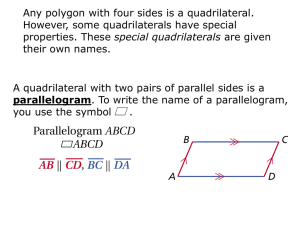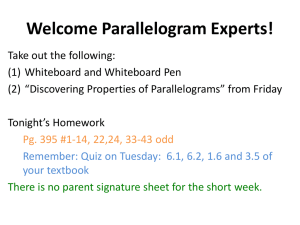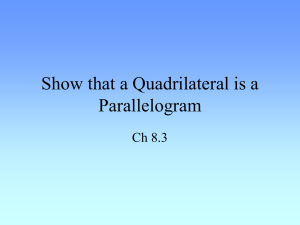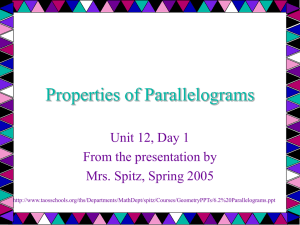Investigating Properties of Parallelograms
advertisement
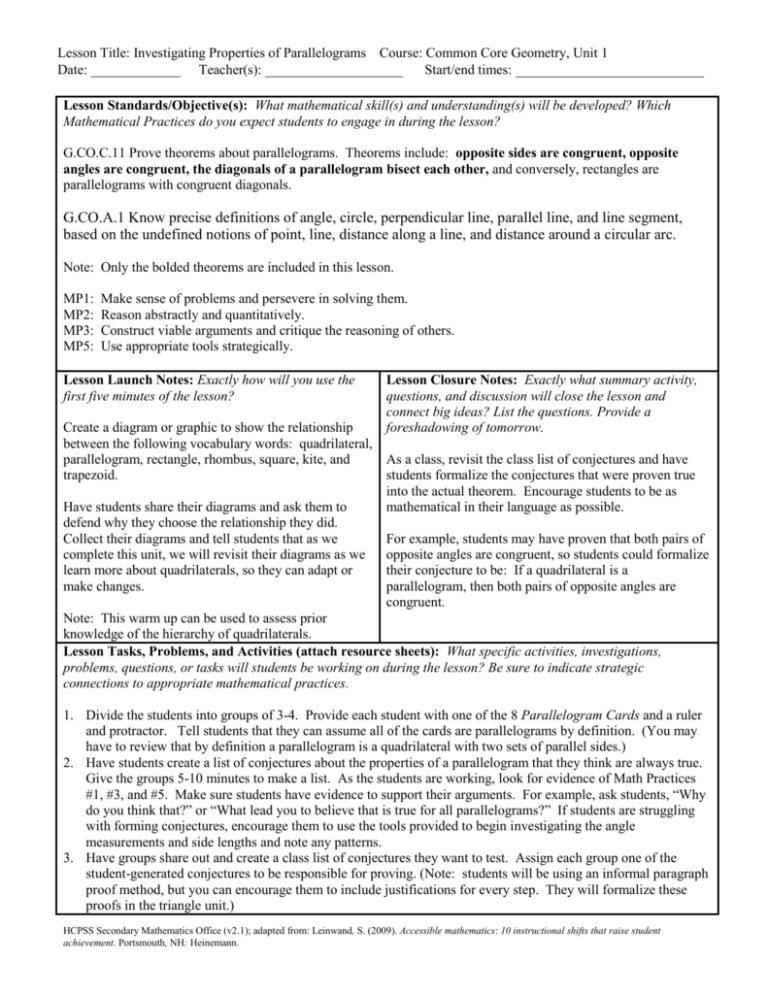
Lesson Title: Investigating Properties of Parallelograms Course: Common Core Geometry, Unit 1 Date: _____________ Teacher(s): ____________________ Start/end times: _________________________ Lesson Standards/Objective(s): What mathematical skill(s) and understanding(s) will be developed? Which Mathematical Practices do you expect students to engage in during the lesson? G.CO.C.11 Prove theorems about parallelograms. Theorems include: opposite sides are congruent, opposite angles are congruent, the diagonals of a parallelogram bisect each other, and conversely, rectangles are parallelograms with congruent diagonals. G.CO.A.1 Know precise definitions of angle, circle, perpendicular line, parallel line, and line segment, based on the undefined notions of point, line, distance along a line, and distance around a circular arc. Note: Only the bolded theorems are included in this lesson. MP1: MP2: MP3: MP5: Make sense of problems and persevere in solving them. Reason abstractly and quantitatively. Construct viable arguments and critique the reasoning of others. Use appropriate tools strategically. Lesson Launch Notes: Exactly how will you use the first five minutes of the lesson? Lesson Closure Notes: Exactly what summary activity, questions, and discussion will close the lesson and connect big ideas? List the questions. Provide a foreshadowing of tomorrow. Create a diagram or graphic to show the relationship between the following vocabulary words: quadrilateral, parallelogram, rectangle, rhombus, square, kite, and As a class, revisit the class list of conjectures and have trapezoid. students formalize the conjectures that were proven true into the actual theorem. Encourage students to be as Have students share their diagrams and ask them to mathematical in their language as possible. defend why they choose the relationship they did. Collect their diagrams and tell students that as we For example, students may have proven that both pairs of complete this unit, we will revisit their diagrams as we opposite angles are congruent, so students could formalize learn more about quadrilaterals, so they can adapt or their conjecture to be: If a quadrilateral is a make changes. parallelogram, then both pairs of opposite angles are congruent. Note: This warm up can be used to assess prior knowledge of the hierarchy of quadrilaterals. Lesson Tasks, Problems, and Activities (attach resource sheets): What specific activities, investigations, problems, questions, or tasks will students be working on during the lesson? Be sure to indicate strategic connections to appropriate mathematical practices. 1. Divide the students into groups of 3-4. Provide each student with one of the 8 Parallelogram Cards and a ruler and protractor. Tell students that they can assume all of the cards are parallelograms by definition. (You may have to review that by definition a parallelogram is a quadrilateral with two sets of parallel sides.) 2. Have students create a list of conjectures about the properties of a parallelogram that they think are always true. Give the groups 5-10 minutes to make a list. As the students are working, look for evidence of Math Practices #1, #3, and #5. Make sure students have evidence to support their arguments. For example, ask students, “Why do you think that?” or “What lead you to believe that is true for all parallelograms?” If students are struggling with forming conjectures, encourage them to use the tools provided to begin investigating the angle measurements and side lengths and note any patterns. 3. Have groups share out and create a class list of conjectures they want to test. Assign each group one of the student-generated conjectures to be responsible for proving. (Note: students will be using an informal paragraph proof method, but you can encourage them to include justifications for every step. They will formalize these proofs in the triangle unit.) HCPSS Secondary Mathematics Office (v2.1); adapted from: Leinwand, S. (2009). Accessible mathematics: 10 instructional shifts that raise student achievement. Portsmouth, NH: Heinemann. Lesson Title: Investigating Properties of Parallelograms Course: Common Core Geometry, Unit 1 Date: _____________ Teacher(s): ____________________ Start/end times: _________________________ 4. Provide students with several tools to prove their conjecture including, but not limited to: MIRAs, geometry software, such as Sketchpad, and/or patty paper. Have each group use at least two ways to prove that their conjecture is true or false. If groups finish early, encourage them to prove their conjectures using additional methods. Remind students that they only need one counterexample to disprove their conjecture. Provide groups with chart paper and markers to allow them to document what they tried. Students can use a two-column, flowchart, or paragraph proof. See the Sample Parallelogram Proofs as a resource. As students continue to work on their proofs, look for evidence of Math Practice #2 and 3. 5. Have students participate in a gallery walk to see which groups have proven or disproved their conjectures and what methods they used. If there is time, students could participate in a jigsaw activity where one member from every group form a new group and present to each other what they have proven or disproved. Evidence of Success: What exactly do I expect students to be able to do by the end of the lesson, and how will I measure student success? That is, deliberate consideration of what performances will convince you (and any outside observer) that your students have developed a deepened and conceptual understanding. Students will be able to develop mathematical conjectures for the properties of parallelograms. Students should also be able to informally prove or disprove their conjecture using at least two different methods and be able to articulate how their method showed the conjecture was true or false. Students should also begin to see the need to label their diagrams and become more specific in their descriptions as they begin to formalize their method of proof. Notes and Nuances: Vocabulary, connections, anticipated misconceptions (and how they will be addressed), etc. Vocabulary: Midpoint, diagonals, bisect, quadrilateral, parallelogram, rectangle, rhombus, square, kite, trapezoid Since some of the parallelogram cards are rectangles, squares, and rhombi, students may form the misconception that a parallelogram has properties that only a square, rectangle, and rhombi have. However, after testing their conjectures, they should realize that their conjectures only work for specific cases. Teachers should encourage students to test different types of parallelograms, so they know their conjecture works for all types of parallelograms. Resources: What materials or resources are essential for students to successfully complete the lesson tasks or activities? Homework: Exactly what follow-up homework tasks, problems, and/or exercises will be assigned upon the completion of the lesson? MIRA Board Geometry Software, such as, Sketchpad Patty Paper Chart paper and markers Parallelogram Cards Is it a Parallelogram? Sample Parallelogram Proofs Have students use their conjectures they formed to determine whether the quadrilaterals are parallelograms in the Is it a Parallelogram? activity. Lesson Reflections: How do you know that you were effective? What questions, connected to the lesson standards/objectives and evidence of success, will you use to reflect on the effectiveness of this lesson? Were my students able to develop conjectures based on their investigation of the properties of a parallelogram? Were my students able to informally prove or disprove their conjectures? HCPSS Secondary Mathematics Office (v2.1); adapted from: Leinwand, S. (2009). Accessible mathematics: 10 instructional shifts that raise student achievement. Portsmouth, NH: Heinemann.
